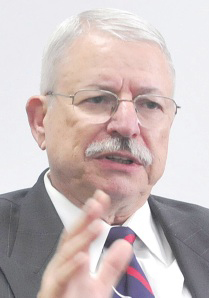By Jimmy Tomlin High Point Enterprise

This 52-inch-long, 3,200-pound steel beam, salvaged from the wreckage of the World Trade Center, was dedicated Thursday morning at the Carolina Field of Honor, in memory of those who died on September 11, 2001. Jimmy Tomlin HPE
KERNERSVILLE —Roscoe “Tad” Tadlock, who survived the deadly terrorist attacks of September 11, 2001, stood near another survivor Thursday morning — a rusty steel beam salvaged from the ruins of the World Trade Center’s South Tower in New York City.
Thirteen years ago, the High Point businessman had been on the 61st floor of the South Tower when a plane crashed into the building only 16 floors above him, causing the 110-story tower to shake violently.
Thursday morning, Tadlock stood a short distance from the 52-inch-long, 3,200-pound steel beam, which was embedded in cement — tilted at an angle, as if it were collapsing — at the Carolina Field of Honor, located in Kernersville’s Triad Park. The beam had just been unveiled as a memorial to the individuals who died on that horrific day, and Tadlock had spoken during the dedication ceremony, reflecting on the tragedy he had somehow survived.
“Even now, just talking about what happened sets me in a crash mode for about a week,” says Tadlock, who is now 65. “I saw (the memorial) for the first time Saturday, and I’ve been back every day since.”
D.H. Griffin, a local demolition company that helped clean up the rubble of the World Trade Center towers, donated the beam to the Carolina Field of Honor.
A stone plaque embedded in front of the beam briefly tells where it came from and who it memorializes. It also includes an inspiring quote from then-President George W. Bush.

Roscoe “Tad” Tadlock of High Point, who was in the World Trade Center’s South Tower on September 11, 2001, says he won’t touch the steel beam or have his photograph made with it. File photo, HPE
“Terrorist attacks can shake the foundations of our biggest buildings, but they cannot touch the foundation of America,” the quote reads. “These acts shatter steel, but they cannot dent the steel of American resolve.”
Following the dedication ceremony, a number of the 300 or so spectators gravitated to the memorial, touching its rough surface with their hands and posing for photographs with the beam.
Tadlock did neither, nor will he.
“I haven’t touched the ironwork,” he says softly, “because I still want to remember the World Trade Center as it was.”
Tadlock also chooses not to watch the 9/11 news footage that invariably shows up on television this time of year, “because I’ve already got all those scenes going around in my head,” he explains.
How could he ever forget them?
How could he forget the massive jolt when the South Tower was struck, throwing him across a desk and knocking some of his Morgan Stanley colleagues to the floor?
Or the red splotches on the plaza down below, which he later learned were people who had jumped or fallen to their death? Or that hideously blood-spattered window beside the plaza? Or the woman dangling from a window, whose deadly drop to the concrete below he watched in its entirety?
Or the large gash in the North Tower, and above it the inferno of intense flames and thick, black smoke?
Or his frantic rush down 61 flights of stairs — and the firefighters he met at the 14th floor, on their way up to help?
Or the firefighter who told him to “run like hell” when he had exited the tower?
Or the severed leg he saw in the middle of a nearby street?
Or the South Tower’s surreal collapse, and the cloud of dust and debris that chased him down the street until he finally ducked into a building to escape it?
How could he ever forget those images? He can’t — and he won’t.
“I’ve never tried to run from it, nor will I try,” Tadlock says. “But you know, when you think about what happened that day, it’s just so outrageous. So many people lost their lives, and they lost their lives in the most inhumane ways.”
That’s why Tadlock keeps returning to the new memorial at the Carolina Field of Honor. It’s just a heavy beam of steel — old and rusted — but it does something for his heavy heart.
“(The Carolina Field of Honor) has strictly been for armed forces up until now,” Tadlock says, “but this memorial honors not only those who died on 9/11, but those who survived, and all of their families, and the first responders. That means a great deal to me.”

